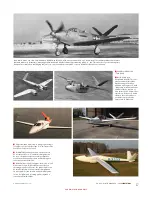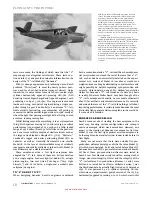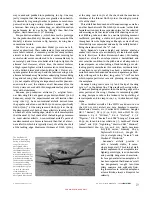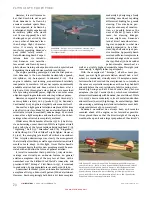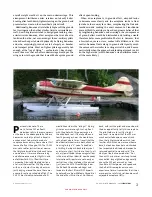
6
A2A
SIMULATIONS :::
ACCU-SIM V35B BONANZA
FOR SIMULATION USE ONLY
Flying Into The Future
V
irtually everyone who gazes upon the
fair proportions of a “V”- tail Beechcraft
Bonanza has come to feel deeply about its
striking appearance. All who have had the
privilege to fly a Bonanza have come to
appreciate its excellent and unique hand-
ing and performance. From its 30º (later 33º) “V”- tail to its
tight and trim cowling Bonanza stands out from the rest.
Bonanza is unlike any other General Aviation (GA) aero-
plane. In the pilot’s seat Bonanza feels different than other
similar aeroplanes, more solid, sturdy and substantial. All
who may be so fortunate as to fly in a Bonanza immedi-
ately perceive the extraordinarily high quality of everything
therein, from the seats, windows and curtains, to the fit-
tings, switches, knobs and levers. Flying a “V”- tail Bonanza
is a unique and satisfying experience. From engine start to
shut- down and throughout the flight “V”- tail Bonanza
handles surely, lightly and quickly, more like a fine- tuned
piston- engine fighter than any other GA aeroplane of its
kind. Whilst Bonanza’s handling characteristics are likely
to get low- time pilots into trouble in a hurry, experienced
and knowledgeable pilots have universally found Bonanza
to be a joy to fly. However, none of this came about acci-
dentally but was a direct result of Beech’s deliberate concept
and design.
Upon its introduction to the public in March 1947 it was
clear to all that this aeroplane was miles and years ahead
of any other light civilian aeroplane, past or present. All
Bonanzas feature a flush- riveted NACA 23000 airfoil wing
which Beech had also used on its Model 18 “Twin Beech,”
a circular, flush riveted stressed aluminium fuselage, fully
enclosed electrically retractable undercarriage, a retractable
by Mitchell Glicksman © 2018
BEECHCRAFT
BONANZA
boarding step, gap- sealed recessed flap tracks, cockpit-
adjustable cowl flaps, internally hinged control sur-
faces and, at first, an electrically pitch- adjustable 2- blade
wooden propeller which soon afterwards was replaced by
a metal constant- speed prop. Most of these features were
commonplace for fighter aircraft of the 1940s but had rarely
ever before appeared on a light civilian aeroplane.
When it was introduced Bonanza did not merely look
supremely clean and fast, its overall drag coefficient (Cd)
was, in fact, the lowest of any light aeroplane in the civil-
ian market.
Beech publicity has often attributed much of Bonanza’s
excellent performance to its unusual “V”- tail. However, as
we shall see, it played virtually no part in contributing to
such and actually had more than a small negative impact on
the aeroplane’s reputation.
SETTING THE SCENE
In January 1945, company officers and engineers at Beech
Aircraft Company, Inc. began to have serious discussions
about what kind of aeroplane they were going to produce
when World War II was over and crucial materials such as
aluminium, steel, rubber and such once again became avail-
able for civilian use.
By this time most of the world had been engaged in the
most savage and deadly war in all of human history in
excess of six years, four months since the Nazi invasion of
Poland, 1 September 1939. Since 7 December 1941 The United
States had been engaged in all theatres of this worldwide
conflict for more than three years and would ultimately
suffer 1,076,245 casualties, the great majority of which had
already been inflicted by January 1945.
Summary of Contents for BONANZA ACCU-SIM V35B
Page 1: ...A2ASIMULATIONS BONANZA ACCU SIM V35B BONANZA ...
Page 3: ...A2ASIMULATIONS BONANZA ACCU SIM V35B BONANZA ...
Page 5: ...www a2asimulations com ACCU SIM V35B BONANZA A2ASIMULATIONS 5 FOR SIMULATION USE ONLY ...
Page 27: ...www a2asimulations com ACCU SIM V35B BONANZA A2ASIMULATIONS 27 FOR SIMULATION USE ONLY ...
Page 58: ......
Page 68: ...68 A2ASIMULATIONS ACCU SIM V35B BONANZA www a2asimulations com FOR SIMULATION USE ONLY ...
Page 112: ......

















